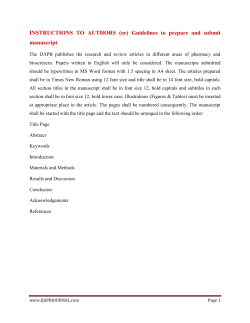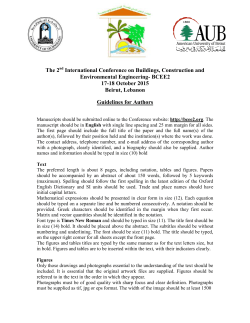
INSTRUCTIONS TO AUTHORS PDF Innovare Journal of
INSTRUCTIONS TO AUTHORS Download PDF Innovare Journal of Education is dedicated to publish good quality of research work & patents in the Education. This Journal publishes original research work that contributes significantly to further the scientific knowledge in Education and its scope is with special emphasis on Education, Reforms in education system, higher education system need and research, Accreditation and quality assurance and other science allied subjects. The Journal publishes original research work either as a Full Research Paper or as a Short communication. Review Articles on a current topic in the said fields are also considered for publication by the Journal. *Type-written manuscripts prepared using MS Word should be submitted by online submission system (http://innovareacademics.in/journals/index.php/ijoe/about/submissions#onlineSubmissions) or email to editor@ijoe.innovareacademics.in *(Article should be submitted through any one of the mode- email or online submission system). Online submission system must be preferred Manuscripts will be subjected to peer review process to determine their suitability for publication provided they fulfill the requirements of the journal as laid out in the instructions to authors. After the review, manuscripts will be returned for revision along with reviewer’s and/or editor’s comments. Prepare the manuscript in Times New Roman font using a font size of 12. There shall not be any decorative borders anywhere in the text including the title page. All the tables and figures should be in the text at suitable place. Submission of a manuscript to Innovare Journal of Education for publication implies that the same work has not been either published or under consideration for publication in another Journal. Authors, in their cover note to the Editor, have to clearly mention whether the manuscript shall be considered as a Research Paper, Short Communication or Review Article and also confirm that the manuscript has not been submitted to any other Journal for publication. Manuscript should be divided into Title page, Abstract, Introduction, Methods, Results, Discussion or Results and Discussion, conclusion, Acknowledgement, References. Title page- In separate lines, title page should contain the title of the manuscript, the name(s) and affiliation(s) of the author(s), and the mailing address, telephone and fax numbers, and e-mail address of the corresponding author. The title must be specific, concise and informative. Title - RECONCEPTUALIZING TEACHER QUALITY -----------(12 FONT SIZE, TIMES NEW ROMAN, NORMAL, BOLD) - IN UPPERCASE ONLY Authors – Stephanie L Knight, Gwendolyn M Lloyd ---(12 FONT SIZE, TIMES NEW ROMAN, NORMAL, BOLD) - IN UPPERCASE ONLY Keywords and Abstract- Please include 3-10 keywords for indexing purposes; Full-length manuscript submission should contain an abstract of up to 250 words in a structured form, consisting of: Objective, Methods, Results, and Conclusion. Headings – INTRODUCTION, METHODS, RESULTS, DISCUSSION, CONCLUSION Subheadings- Current considerations for teaching quality Introduction- It should summarize the rationale, provides a concise research background (not an exhaustive review) and states in single sentence the objective of the study. Please do not include any results or the conclusion of the study. Materials and methods- All the ethical permission associated in the research work must be specified. It should provide technical information about the study. Published methodological details are not needed to describe that have been published previously. Results- It should reveal the findings of works. Discussion- It should be with the interpretation of the results and their comparison with those of other studies. No need to repeat the results, review literature, textbook knowledge or cite references that do not have a close relationship with the present result. Conclusion – conclude the study linking back to the aim of the study. Innovare Journal of Education Abbreviations- At the first appearance in the abstract and the text, abbreviations should be preceded by words for which they stand. Tables- Tables must be concise and cited consecutively using Arabic numerals in the text (Table 1, Table 2...etc.). The title of the table should clearly indicate the nature of the contents and sufficient detail should be included in the footnote to facilitate interpretation without reference to the text. Use horizontal rules only. Table Format – It should be designed using table tools of MS Word and exactly same as below Table 1: ---(12 font size, times new roman, normal, bold) Heading 1 Data Data Data Data Column heading 2 (unit) Figures -Figures (photographs, drawings, diagrams and charts) should be clear, easily legible and cited consecutively using Arabic numerals in the text(fig. 1, fig. 2...etc.). Please supply figures 1.5 to 2 times the size at which they will be finally reproduced. For line work, submit black-ink drawings of professional quality. Micrographs or other glossy photographs must be of the highest quality. Use standard symbols: ○, ●, ×, □, ■, △, ▲. Freehand or typewritten lettering is unacceptable. If a figure comprises more than one glossy photograph, these should be marked A, B, C...etc. Figure legends should be marked clearly with their correspond letters. Legends should contain sufficient detail to permit figure interpretation without reference to the text. Scale markers should be indicated in the photographs. Color plates are also welcome. The choice of cover art illustration will be made by the Editor. Figure format – Fig. 1: ---(12 Font size, Times new roman, normal, Bold) Manuscripts that fail to conform to the requirements of the Journal, as specified under 'Instructions to Authors', will be rejected outright. Tables and figures should be cited in the text in numerical order. Table 2 should not be first cited before table 1. References References should be numbered consecutively in the order in which they are first mentioned in the text (not in alphabetic order). Identify references in text, tables, and legends by Arabic numerals in parenthesis/bracket like- [1]. References cited only in tables or figure legends should be numbered in accordance with the sequence established by the first identification in the text of the particular table or figure. Use the style of the examples below. Use complete name of the journal for non-indexed journals. Avoid using abstracts as references. Information from manuscripts submitted but not accepted should be cited in the text as “unpublished observations” with written permission from the source. Avoid citing a “personal communication” unless it provides essential information not available from a public source, in which case the name of the person and date of communication should be cited in parentheses in the text. For scientific articles, contributors should obtain written permission and confirmation of accuracy from the source of a personal communication. Articles in Journals 1. Allen MC, Black R. The future of higher education in Australia. J Higher Educ 1995;15(2):16-25.List the first six contributors followed by et al. 3. Issue with supplement: Klimoski R, Palmer S. The ADA and the hiring process in organizations. Consult Psychol J: Pract Res 1993;45(1, Suppl 2):10-36 2. Volume with supplement: Allen MC, Black R. The future of higher education in Australia. J Higher Educ 1995;15 Suppl 2:16-25. Books and Other Monographs Innovare Journal of Education 1. 2. Personal author(s): Good T, Brophy J. Looking in classrooms. 10th ed. Boston MA: Allyn & Bacon; 2008. Editor(s), compiler(s) as author: Norman IJ, Redfern SJ, editors. Statement of financial accounting concepts. New York: Churchill Livingstone;1996. 3. Roell Craig H. "The development of learning and teaching" In: Changing Higher Education 1890–1930. ed. Jessica H Foy, Karal Ann Marling. Knoxville TN: University of Tennessee Press; 1994. p. 193-204. Journal abbreviations source Journal names should be abbreviated according to CAS Source Index (CASSI) Search Tool abbreviations: http://cassi.cas.org/search.jsp Review Articles Should be about 18 pages long, contain up-to-date information, comprehensively cover relevant literature and preferably be written by scientists who have in-depth knowledge on the topic. All format requirements are same as those applicable to full papers. Review articles need not be divided into sections such as Materials and Methods and Results and Discussion, but should definitely have an Abstract and Introduction, if necessary. Short Communication The journal publishes exciting findings, preliminary data or studies that did not yield enough information to make a full paper as short communications. These have the same format requirements as full papers but are only up to 5 pages in length. Short Communications should not have subtitles such as Introduction, Materials and Methods, Results and Discussion - all these have to be merged into the running text. Short Communications preferably should have only 3-4 illustrations. Conflict of Interest statement It must be declared by authors.
© Copyright 2025














